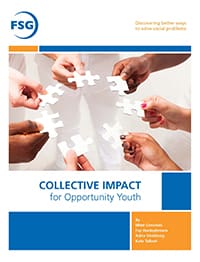A proven, successful framework for communities to improve outcomes for opportunity youth—the nearly 7 million Americans between 16 and 24 who are neither employed nor in school.
Top Takeaways
- Opportunity youth face a range of challenges: low performing schools, limited community resources, a lack of family support, and inadequate assistance from systems charged with serving them.
- Failure to improve outcomes for opportunity youth negatively affects both the individuals and their communities, costing taxpayer dollars, increasing criminal activity, and depriving the workforce of skilled potential employees.
- Breaking the cycle of poverty for opportunity youth requires a long-term, collaborative commitment from all sectors, including schools, government agencies, employers, and nonprofits.

